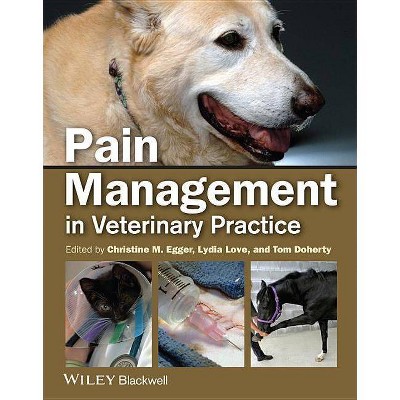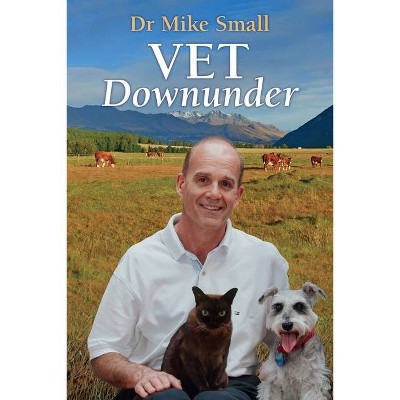Pain Mgmt Small Animal Vet Pra - by Lydia Love & Christine M Egger & Tom Doherty (Paperback)

Similar Products
Products of same category from the store
AllProduct info
<p/><br></br><p><b> Book Synopsis </b></p></br></br><p><i>Pain Management in Veterinary Practice</i> provides veterinary practitioners with the information needed to recognize and manage pain in a wide range of large, small, and exotic animal species. Encompassing acute, adaptive, and chronic, maladaptive pain, the book provides an up-to-date review of the physiology and pathophysiology of pain. <i>Pain Management in Veterinary Practice</i> offers specific strategies for addressing pain in animals, including local and regional analgesia, continuous rate infusions, and novel methods of analgesic drug delivery.</p> <p>With comprehensive information on the pharmacokinetic and pharmacodynamic characteristics of analgesic drugs, the book goes beyond pharmaceutical options to incorporate scientific information on techniques for complementary treatment, including physical therapy, acupuncture, chiropractic techniques, and nutritional strategies. <i>Pain Management in Veterinary Practice</i> is a valuable resource for developing pain management protocols in the veterinary clinic.</p><p/><br></br><p><b> From the Back Cover </b></p></br></br><p><i>Pain Management in Veterinary Practice</i> provides veterinary practitioners with the information needed to recognize and manage pain in a wide range of large, small, and exotic animal species. Encompassing acute, adaptive, and chronic, maladaptive pain, the book provides an up-to-date review of the physiology and pathophysiology of pain. <i>Pain Management in Veterinary Practice</i> offers specific strategies for addressing pain in animals, including local and regional analgesia, continuous rate infusions, and novel methods of analgesic drug delivery.</p> <p>With comprehensive information on the pharmacokinetic and pharmacodynamic characteristics of analgesic drugs, the book goes beyond pharmaceutical options to incorporate scientific information on techniques for complementary treatment, including physical therapy, acupuncture, chiropractic techniques, and nutritional strategies. <i>Pain Management in Veterinary Practice</i> is a valuable resource for developing pain management protocols in the veterinary clinic.</p> <p><b>Key features</b></p> <ul> <li>Provides clinicians with essential information on identifying and treating pain in animals</li> <li>Covers pain management in a variety of species, including dogs, cats, birds, reptiles, small mammals, ruminants, camelids, pigs, and horses</li> <li>Offers practical methods for managing pain, including pharmaceutical and complementary options</li> <li>Presents two chapters specifically covering cancer pain and its treatment</li> <li>Includes advice on integrating pain management into your veterinary practice</li> <li>Discusses palliative and hospice care for veterinary patients</li> </ul><p/><br></br><p><b> Review Quotes </b></p></br></br><br><p>"The information in this book is more extensive and diverse than that found in other currently available books. It fills a much-needed void in a rapidly expanding area of veterinary medicine." (<i>Doody's</i>, 3 October 2014)</p> <p>'The veterinary profession has begun to make pain management a priority' is the opening line to the chapter 'Integrating pain management into veterinary practice', and I couldn't agree more. The publication of a textbook dedicated to all aspects of pain management presented in an easily accessible format will be an excellent addition to any practice's library." (<i>Veterinary</i> <i>Record</i>, 16 August 2014)</p> <p>"It is practical, well-illustrated, and gives information on analgesia in a variety of species." (<i>Vets Today</i>, 1 August 2014)</p> <p>"Overall, the text is well written; the chapters are logically organized, and information is easily accessible. The book is reasonably priced and will be an excellent addition to any veterinarian's library and very useful to veterinary students and technicians as well." (<i>Journal of the American Veterinary Medical Association</i>, 15 June 2014)</p> <p>"Benefitting from the contribution of more than 40 international expert authors, this excellent book provides a huge amount of up to date, evidence-based theoretical and practical information on pain management in veterinary practice and should definitely find its place on the bookshelf of all practitioners interested in better understanding and treating pain in their patients (aren't we all )." (<i>European Journal of Companion Animal Practice</i>, 1 July 2014)</p> <p>"The result is a fine survey highly recommended for any working with animals." (<i>Midwest Book Review</i>, 1 June 2014)</p> <p>"Pain Management in Veterinary Practice is a reference for veterinary offices and practitioners and considers the physiology and pathophysiology of all kinds of animal pain, from large to exotic species. Expect more from this than an overview of pain medications and their administration and management: chapters cover techniques for complimentary treatments from acupuncture to massage and physical therapy, consider nutrition's role in pain management, and provide specific advice for specific kinds of pain. The result is a veterinary handbook recommended for any practitioner." (<i>Midwest Book Review</i>, 1 April 2014)</p> <p> </p><br><p/><br></br><p><b> About the Author </b></p></br></br><p><b>Christine M. Egger</b>, DVM, MVSc, CVH, CVA, Diplomate ACVAA, is a Professor of Anesthesiology and Pain Management at the University of Tennessee in Knoxville, Tennessee, USA.</p> <p><b>Lydia Love</b>, DVM, Diplomate ACVAA, practices anesthesia and pain management at Animal Emergency and Referral Associates in Fairfield, New Jersey, USA.</p> <p><b>Tom Doherty</b>, MVB, MSc, Diplomate ACVAA, is a Professor of Anesthesiology at the University of Tennessee in Knoxville, Tennessee, USA.</p>
Price History
Price Archive shows prices from various stores, lets you see history and find the cheapest. There is no actual sale on the website. For all support, inquiry and suggestion messages communication@pricearchive.us




















